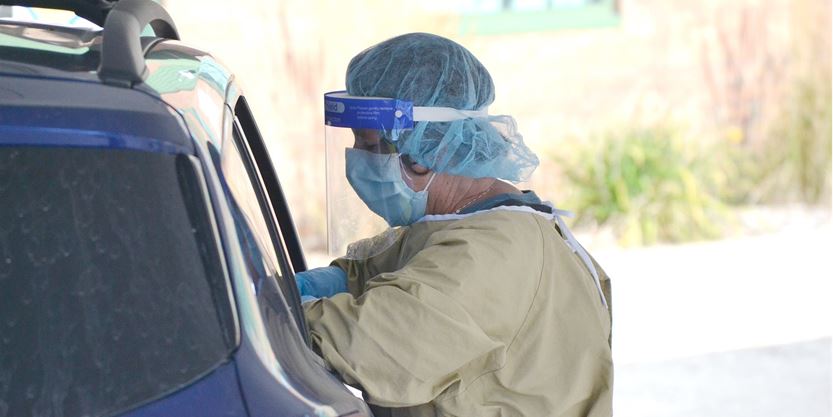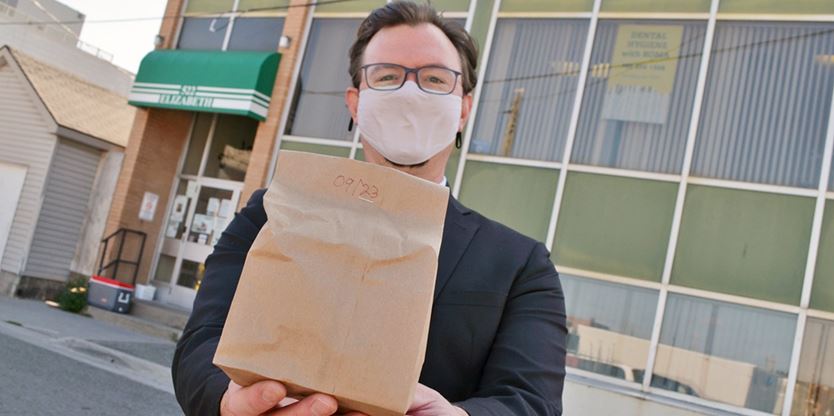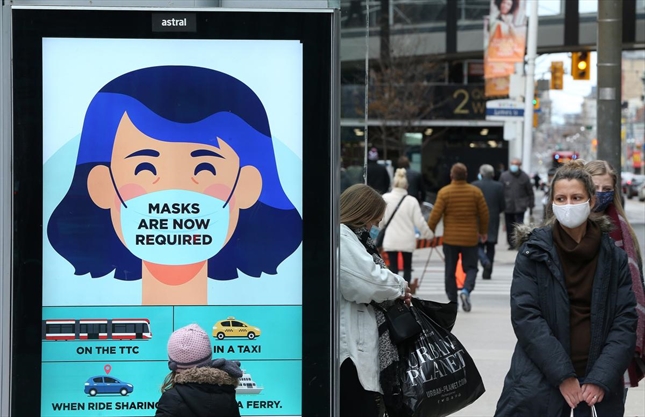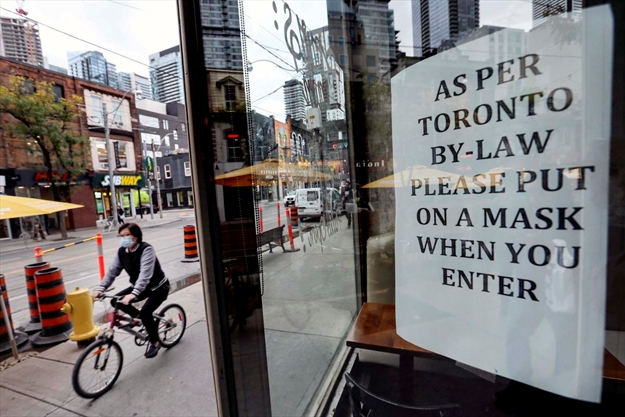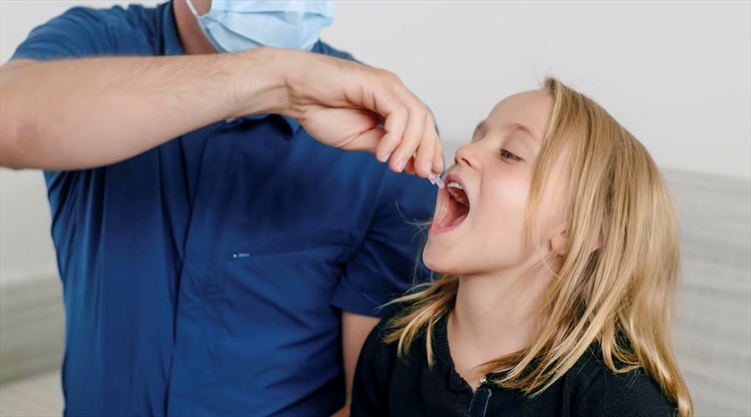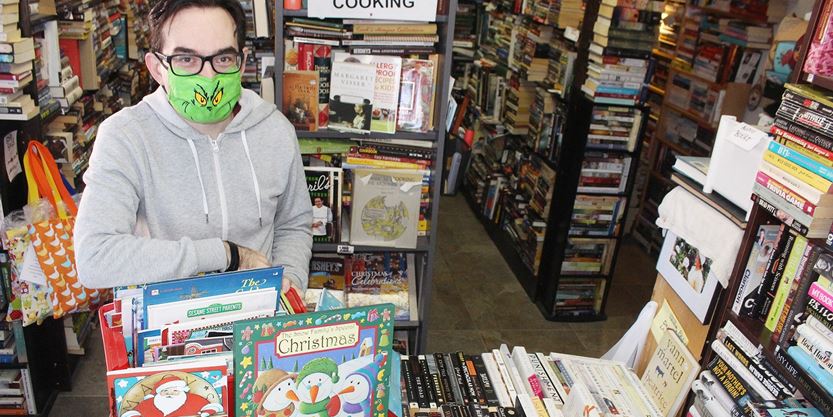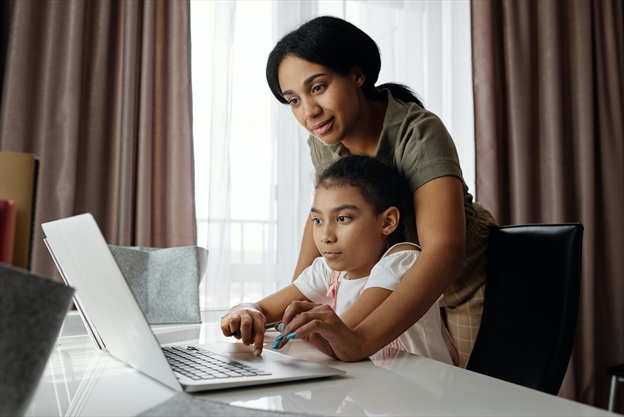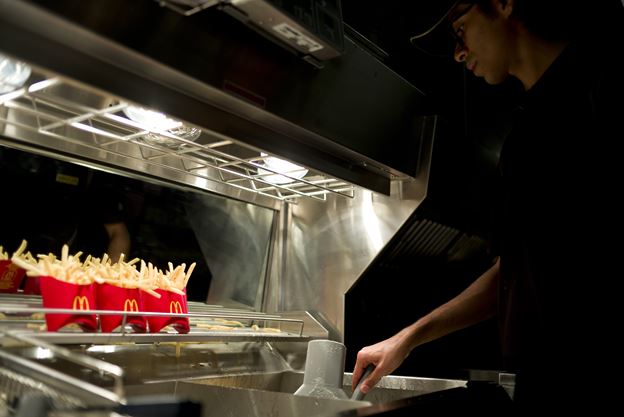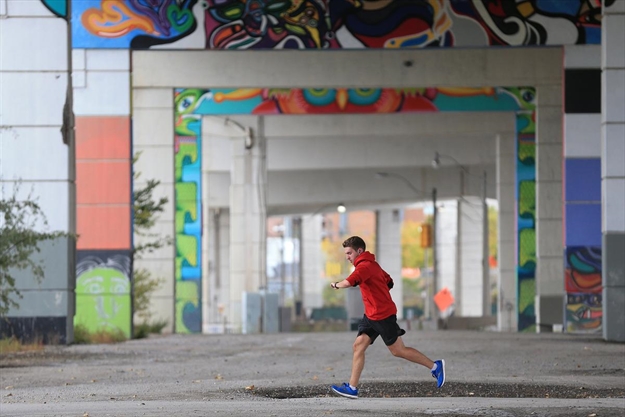The latest news from Canada and around the world Monday. This file will be updated throughout the day. Web links to longer stories if available.
6:35 p.m.: The Centre for Addiction and Mental Health has reported a COVID-19 outbreak at its Queen Street West site, with five patients testing positive for the virus. It is the first outbreak at Canada’s largest mental health hospital since April.
Two patients were said to have COVID-19 on Sunday. By Monday at 5 p.m., CAMH updated their website to reveal three more patients had tested positive, bringing the total to five current patients with the virus.

The new outbreak brings the number of patients who have tested positive for the virus at CAMH to 29 since the pandemic began. Nineteen have since recovered and three were discharged.
6:30 p.m.: The rate of COVID-19 testing in the part of the city hit hardest by the virus is lagging behind other neighbourhoods, data newly posted by Toronto Public Health shows.
That data, released Monday and current to Oct. 4, shows that eight of the 10 neighbourhoods with the highest per cent positivity for COVID-19 are in the northwest part of the city, .
At the same time, all eight of those neighbourhoods had rates of testing below the average for neighbourhoods where there was data available.
On Monday, the city’s board of health called on the province to increase the availability and accessibility of pop-up testing in neighbourhoods disproportionately affected by the pandemic.
Dr. Eileen de Villa, the city’s medical officer of health, said Monday that more testing is needed to “fully understand” what’s happening in those neighbourhoods.
5:40 p.m.: Toronto’s restaurants and bars are scrambling to extend patio season for as long as possible following the 28-day ban imposed October 10 on indoor dining — but many are finding that winterizing is more difficult than they thought, and some are closing down altogether for the time being.
“There’s no confidence, really, that people will flock to outdoor patios in the winter,” said James Rilett, Restaurants Canada’s vice-president for central Canada. This uncertainty has left restaurant owners wondering if they’ll be worth the investment, he said.
And while some restaurants are charging ahead with winterizing their patios for the long haul, it’s a select few — and it’s a challenge, given the current shortage of space heaters caused by increased demand, said Ryan Mallough, director of provincial affairs for Ontario for the Canadian Federation of Independent Business (CFIB).
3:45 p.m.: The total number of COVID-19 cases in Canada has passed 200,000.
The latest case numbers from Saskatchewan lifted the national tally over the bleak milestone.
The development comes just over four months after Canada reached the 100,000-case threshold.
The bulk of the country’s case load has been concentrated in Ontario and Quebec, though numbers have been surging in much of the country in recent weeks as Canada deals with a second wave of the global pandemic.
2:30 p.m.: When Jesse James Laderoute went to check his EI deposit last week, it wasn’t quite what he’d been expecting.
“I thought it was going to be $1,000, but it was only $750,” said the Toronto bartender, who was transitioned to EI after the Canada Emergency Response Benefit ended at the end of September.
When he figured out why the deposit was smaller, he got angry. He’d managed to pick up a shift or two to bring in an extra bit of money to supplement EI, and reported the income to Service Canada. For every dollar he’d earned, 50 cents of his EI benefit had been clawed back.
“I’m putting myself at risk of catching this virus for $6.10 an hour. It really doesn’t seem worth it,” said Laderoute, referring to his income after the clawback is factored in.
While the clawback is a standard EI rule, Laderoute figured things would be different during the COVID-19 pandemic. Self-employed and freelance workers collecting the Canada Recovery Benefit, after all, won’t see any clawbacks until after they hit $38,000 per year.
.
1:45 p.m. Fake reviews on Amazon.com Inc. during the pandemic .
About 42 per cent of 720 million Amazon reviews assessed by the monitoring service Fakespot Inc. from March through September were unreliable, up from about 36 per cent for the same period last year. The rise in fake reviews corresponded with the stampede online of millions of virus-avoiding shoppers.
“We’ve only seen those kinds of numbers in the Black Friday or Christmas period in 2019,” said Fakespot founder and chief executive officer Saoud Khalifah. “In 2020, the surge of fake reviews has proliferated in a rapid manner coinciding with lockdown measures in the USA.” By contrast, almost 36 per cent of Walmart.com reviews assessed by Fakespot during the same period were fake — about the same as last year.
1:41 p.m. U.S. President Donald Trump complained to his campaign staff about the government’s top infectious disease expert, Anthony Fauci, including him among people he considers “idiots,” but said he couldn’t fire him because of public perception.
“People are tired of hearing Fauci and all these idiots,” Trump said Monday in a call intended to boost morale at a campaign running well behind his challenger, Joe Biden. Trump’s campaign invited reporters to listen in.
“Anytime he goes on television” there’s a “bomb,” Trump told his staff, adding that if he fired Fauci it would be a “bigger bomb.”
He claimed without substantiation that “if we listened to him” there would be 700,000 to 800,000 American deaths. More than 220,000 Americans have died so far from the coronavirus.
After disparaging Fauci, Trump remarked that he didn’t care whether reporters were on the call.
1:38 p.m. Your personal health information could soon be a click away on your iPhone or Android device, making health-care delivery easier for doctors, nurses, and patients during the .
Treasury Board President Peter Bethlenfalvy is pushing an ambitious digital strategy to improve Ontarians’ access to a slew of government services at a time when so many are working from home.
“We need to adapt to Ontario’s new reality. People are 100 per cent ready,” Bethlenfalvy said Monday as he unveiled an 18-page “COVID-19 action plan for a people-focused government.”
“COVID-19 is accelerating things,” he said.
The most significant of the 30 priorities outlined in the document is a “digital identity” profile that would allow people to safely store government-issued personal information in their phones.
“Verified, digital information about you, such as the information found on your health card, driver’s licence and birth certificate, can be securely stored in a digital wallet on your smartphone and conveniently used to prove your identity to access services when required,” the action plan says.
This would “provide new and improved digital health solutions to frontline care personnel, so they can rapidly and securely access a patient’s health records from anywhere and from any device.”
12:14 p.m. The number of new COVID-19 cases in public schools across the province has jumped by 74 in its latest report, to a total of 749 in the last two weeks.
In the province reported 48 more students were infected for a total of 430 in the last two weeks; since school began there has been an overall total of 736 cases.
The data shows there are 10 more staff members for a total of 106 in the last two weeks — and an overall total of 203.
The latest report also shows 16 more individuals who weren’t identified for a total of 213 in that category — and an overall total of 373.
There are 483 schools with a reported case, which the province notes is 10 per cent of the 4,828 public schools in Ontario.
11:30 a.m.: The number of new COVID-19 cases in public schools across the province has jumped by 74 in its latest report, to a total of 749 in the last two weeks.
In the province reported 48 more students were infected for a total of 430 in the last two weeks; since school began there has been an overall total of 736 cases.
The data shows there are 10 more staff members for a total of 106 in the last two weeks — and an overall total of 203.
The latest report also shows 16 more individuals who weren’t identified for a total of 213 in that category — and an overall total of 373.
There are 483 schools with a reported case, which the province notes is 10 per cent of the 4,828 public schools in Ontario.
11:30 a.m.: Quebec is reporting 1,038 new cases of COVID-19 and six more deaths attributed to the novel coronavirus.
Health officials say two of those deaths occurred in the past 24 hours, one occurred between Oct. 12 and 17, and three newly linked COVID deaths occurred at unknown dates.
Hospitalizations increased by five compared with the prior day, for a total of 532, and 92 of those patients were in intensive care, an increase of four.
Quebec has reported a total of 94,429 cases of COVID-19 and 6,044 deaths linked to the virus.
10:45 a.m. (updated): There are 704 new cases of COVID-19 in Ontario today, and four new deaths due to the virus.
Health Minister Christine Elliott says 244 cases are in Toronto, 168 in Peel Region, 103 in York Region and 51 in Ottawa.
Ontario also reported 74 new COVID-19 cases related to schools, including at least 48 among students.
10:20 a.m. The pandemic has made it too scary for door-to-door trick or treating in Toronto, Peel, York and Ottawa, says Ontario’s chief medical officer.
Dr. David Williams said Monday the “high transmission” of COVID-19 in the four regions now under modified Stage 2 restrictions has prompted him to recommend against the traditional candy collection.
The announcement came as the province reported another 704 cases of the virus, bringing the total since Friday to 2,167.
10:17 a.m. Ontario is reporting 704 cases of COVID-19 and four new deaths. Locally, there are 244 new cases in Toronto, 168 in Peel, 103 in York Region and 51 in Ottawa. Almost 31,900 tests were completed.
10:12 a.m. South Africa’s health minister Dr. Zweli Mkhize has announced that he and his wife have tested positive for COVID-19 and warned of a possible resurgence of the disease in the country.
Mkhize and his wife got positive results after they both displayed symptoms, he said in a statement.
“I was feeling abnormally exhausted and as the day progressed, I started losing appetite. My wife had a cough, was dizzy and was extremely exhausted,” he wrote. His wife May, who is also a doctor, has been hospitalized for observation and rehydration, he said.
Mkhize emphasized that South Africans should continue to wear masks and sanitize their hands to avoid more infections.
“As a country, we’ve made significant strides in our fight against this pandemic. Let us not dare regress,” he said. “Whatever we do and wherever we go, we have to keep in mind that there remains a risk of a second wave.”
He said family members and colleagues who were in contact with him have been informed to isolate and test for the disease.
10 a.m. (will be updated) Canada is extending non-essential travel restrictions with the U.S. until Nov. 21, Public Safety Minister Bill Blair said Monday. The ban has been in place since March.
9:42 a.m. Wales has become the second nation in the United Kingdom to lock down large swaths of its economy to combat rising coronavirus infections, even as British Prime Minister Boris Johnson is resisting loud calls to do the same throughout England.
Wales’ First Minister Mark Drakeford said Monday that his administration was backing a short, sharp “firebreak” to slow the spread of COVID-19. All non-essential retail, leisure, hospitality and tourism businesses will close for two weeks beginning at 6 p.m. Friday — a lockdown similar in scope to the U.K.-wide measures imposed in March.
“This is the moment to come together to play our part in a common endeavour to do everything we can together to protect the (National Health Service) and to save lives,’’ Drakeford said.
Àuthorities across the U.K. are imposing new restrictions on business and social interactions as COVID-19 infections rise throughout all age groups and parts of the country, filling hospital beds and intensive care wards. One of their main goals is to reduce the strain on the NHS ahead of the winter flu season.
Public health experts say a lockdown can help reset the pandemic at a lower level, giving doctors time to treat the ill and providing breathing room for the government to improve its response. Britain has the deadliest coronavirus outbreak in Europe, with over 43,700 confirmed deaths.
9:32 a.m. Those heading to rally at the Des Moines airport on Wednesday were greeted by a billboard: “TRUMP COVID SUPERSPREADER EVENT,” it read, above a giant arrow pointing to the rally.
The didn’t deter the Trump faithful. Coronavirus cases are , and Iowa has set records for the number of new COVID hospitalizations , but people packed like sardines into the airport hangar, very few wearing masks, to see the nation’s highest-profile COVID patient.
It was part of Trump’s comeback tour of rallies last week (in Pennsylvania, Florida, Iowa and North Carolina) since declaring himself cured. At the crowded events, he badmouthed mask usage (suggesting that masks may be a source of spread rather than protection), Dr. Anthony Fauci (who warned the rallies were “”) and said to those suffering: “I feel your pain because I felt your pain.” Then he said he “felt like Superman” and that the U.S. was “rounding the corner” on the virus.
8:42 a.m. The novel coronavirus has been around for less than a year and already the science is changing.
An early study in June found few or no antibodies in asymptomatic carriers only weeks after infection, suggesting a lack of immunity, but more recent studies have shown that people who have no or little symptoms can launch a robust T-cell immune defence.
And a recent study in Australia showed that in a darkened lab, the virus can live on surfaces such as cellphone screens for up to 28 days, weeks longer than earlier studies, albeit under different conditions.
As we move inside for a period that is once again new in our COVID-19 world — winter — we ask experts to update some of the emerging science that will undoubtedly have to be updated yet again in the coming months, and ask for some advice on how to stay safe indoors.
8:10 p.m. Bars and restaurants across Belgium shut down for a month and a night-time curfew took effect Monday as health authorities warned of a possible “tsunami” of new virus cases in the hard-hit nation that host the European Union’s headquarters.
The new measures aim to limit social interactions to slow down the exponential growth of the pandemic in the nation of 11.5 million people. The new surge of coronavirus cases has already prompted several hospitals to delay nonessential operations to focus on treating COVID-19 cases.
“We are really very close to a tsunami,” Health Minister Frank Vandenbroucke told broadcaster RTL.
According to AP figures based on data collected by Johns Hopkins University, Belgium recorded an average of 73.95 daily cases per 100,000 people over the past seven days, the second-worst record in the EU behind the Czech Republic.
Yves Van Laethem, the COVID-19 crisis centre spokesman, said Monday that 7,876 daily new cases were diagnosed on average over the past seven days, up 79 per cent compared with the previous week. Van Laethem said the epidemiological situation could be even worse, given delays in the publication of test results.
7:32 p.m. Mayor John Tory thinks dance studios in Toronto should not be forced to close along with gyms in parts of Ontario with the most COVID-19 infections.
Asked Monday morning on CP24 about complaints from dance studio owners, Tory said: “I don’t think they should be either, by the way … People enrol in specific classes, (operators) are better able to keep a handle on social distancing and so on. I think we should find a way to let those kind of activities proceed subject to safety rules. We’ll see how (public health officials) sort that out.”
Tory’s comments came after Lisa MacLeod, Ontario’s Minister for Tourism, Culture and Sport, said she is working with officials to find a way to let dance studios reopen in so-called “hot zones” moved back to a modified Stage 2 reopening.
MacLeod tweeted that she has heard from dance studio instructors “loud and clear” and is working toward “options to ensure a safe resumption.”
Tory also told CP24 he expects provincial public health officials to very soon reveal advice for Ontario parents and kids on how to safely celebrate Halloween.
The mayor hinted that Toronto’s input included strong concern about kids knocking on doors and having close contact with residents.
Tory said he’s heard many concerns that “if you’ve taken all the measures you’ve taken with respect to trying to protect kids, and keep schools open and protect people from the virus, that you’re obviously going to be adopting a very cautious approach with respect to Halloween … The concern has been expressed — that people, by going up and knocking on doors, are having a closer kind of contact than we were even advising to do on Thanksgiving … Let’s wait and see what the provincial medical officer of health has to say, and then the governments have to decide what to do with that advice.”
7:21 a.m. Iran recorded its worst day of new deaths since the start of the coronavirus pandemic, with 337 confirmed dead on Monday.
The grim milestone represents a significant spike from the previous single-day death toll record of 279. The Health Ministry also announced 4,251 new infections, pushing the total count to 534,630.
Fatalities have soared in recent weeks, as authorities struggle to contain the virus’s spread months into the pandemic. Health officials say the capital, Tehran, has run out of intensive care beds.
The Islamic Republic has seen the worst outbreak in the Middle East with a death toll that topped 30,000 this week. The government has resisted a total lockdown to salvage its devastated economy, already weakened by unprecedented U.S. sanctions.
As the death toll skyrockets, eclipsing the previous highs recorded in the spring amid the worst of its outbreak, authorities have started to tighten restrictions. The government ordered shut recently reopened schools and universities, as well as museums, libraries and other public places in Tehran earlier this month, and imposed a mask mandate outdoors.
The timing of the pandemic has proved particularly difficult for Iran’s economy. The Trump administration re-imposed economic sanctions on Iran after its unilateral withdrawal in 2018 from Tehran’s nuclear accord with world powers.
5:46 a.m.: India has reported 579 fatalities from COVID-19 in the past 24 hours, the lowest increase in three months, driving its death toll to 114,610. The Health Ministry on Monday also reported 55,722 more people infected, raising India’s total to more than 7.5 million.
A government-appointed committee of scientists said Sunday the disease was likely to “run its course” by February if people used masks and adhered to distancing measures.
The number of new infections confirmed each day has declined for a month. The committee said even if active cases increased during the upcoming festive season and cold weather, they were unlikely to surpass India’s record daily high of 97,894 cases.
5:46 a.m.: South Korea on Monday began testing tens of thousands of employees of hospitals and nursing homes to prevent COVID-19 outbreaks at live-in facilities.
Fifteen of the 76 latest cases reported by the Korea Disease Control and Prevention Agency were from the southern port city of Busan, where more than 70 infections have been linked to a hospital for the elderly.
The disease caused by the coronavirus can be more serious in older people and those with existing health conditions like high-blood pressure.
5:45 a.m.: After entire nations were shut down during the first surge of the coronavirus earlier this year, some countries and U.S. states are trying more targeted measures as cases rise again around the world, especially in Europe and the Americas.
New York’s new round of virus shutdowns zeroes in on individual neighbourhoods, closing schools and businesses in hot spots measuring just a couple of square miles.
Spanish officials limited travel to and from some parts of Madrid before restrictions were widened throughout the capital and some suburbs.
Italian authorities have sometimes quarantined spots as small as a single building.
While countries including Israel and the Czech Republic have reinstated nationwide closures, other governments hope smaller-scale shutdowns can work this time, in conjunction with testing, contact tracing and other initiatives they’ve now built up.
The concept of containing hot spots isn’t new, but it’s being tested under new pressures as authorities try to avoid a dreaded resurgence of illness and deaths, this time with economies weakened from earlier lockdowns, populations chafing at the idea of renewed restrictions and some communities complaining of unequal treatment.
5:45 a.m.: The number of confirmed cases of COVID-19 across the planet has passed 40 million.
The milestone was passed early Monday according to Johns Hopkins University, which collates reporting from around the world.
The actual figure is likely to be far higher, as testing has been variable, and many people have had no symptoms.
5:44 a.m.: Stricter public health measures come into effect in York Region today in a bid to tackle what the Ontario government has called an “alarming” surge in COVID-19 cases.
The region north of Toronto has moved back into a modified Stage 2 of the province’s pandemic plan.
Indoor service in restaurants is prohibited, gyms and movie theatres are closed and public gatherings can be no larger than 10 people indoors or 25 people outdoors.
The measures will be in effect for 28 days — two incubation cycles for the novel coronavirus.
York Region accounted for 94 of the province’s 658 new COVID-19 cases yesterday, and 93 of Saturday’s 805 cases.
Sunday 7:15 p.m. St. Joseph’s hospital COVID-19 outbreaks in four units at its site Friday. As of Sunday morning, seven patients and 13 staff members had been infected.
The hospital is expected to implement a widespread testing of staff and patients in the coming days.
“We want to assure our community that St. Joseph’s is a safe place to receive care and emergency services,” said Unity Health spokesperson Robyn Cox.
An outbreak was also declared Thursday in two units at Toronto Western hospital, with six staff members and three patients affected as of Sunday.
A third outbreak was confirmed at CAMH’s Queen Street West site, where two patients were confirmed positive.
The discretion used to indicate an outbreak is when at least two staff or patients have test results that are positive for COVID-19.
updated Sunday, the hospital will be closing the COVID-19 impacted unit to admissions and transfers.
“We continue to remain vigilant about policies and procedures to keep staff and patients safe and we are working with our partners at Toronto Public Health on reporting, surveillance and infection control,” the news release said.

